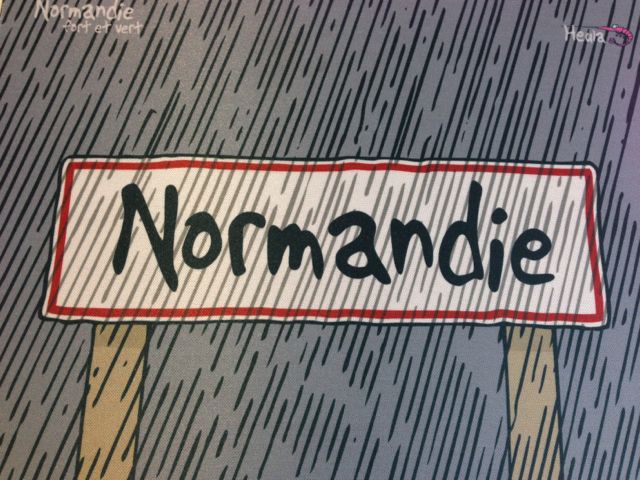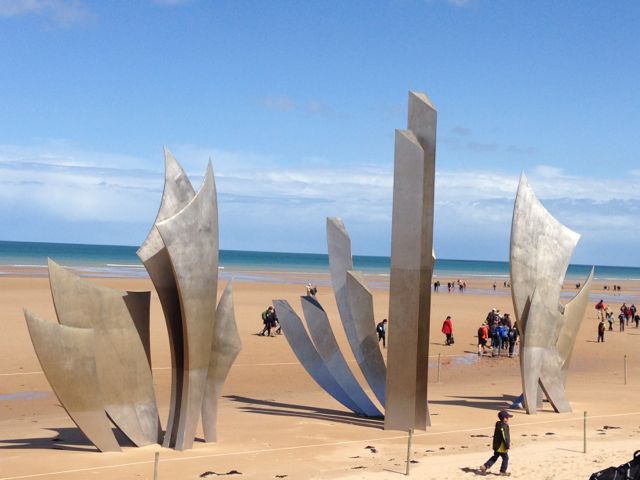This year is the 70th anniversary of the D-Day landings on 6 June 1944 which started the invasion by the Allied forces of Nazi-occupied France during World War II. The Battle of Normandy (code named Operation Overlord) started with an airborne assault of 1200+ planes and 160,000 troops deposited off the beaches of Normandy. The Canadians landed at Juno Beach, the Americans at Utah and Omaha beaches and the British at Sword and Gold beaches. On that first day alone, over 4000 Allied forces and 1000 Germans were killed, with many more injured.
We recently visited the D-Day beaches and the sites of the Battle of Normandy in France as part of a trans-atlantic camporee organised by the Boy Scouts of America to kick off 70th anniversary commemorative events lasting through August 2014. I found these historic World War II sites surprising for a few reasons:
The weather is dismal.
I don’t know why I thought all of France generally had pretty good weather. The joke was on me. Apparently, Normandy’s weather is famous for being unlike the rest of the country. When the Normans took over England in 1066, they probably were thrilled to be somewhere it rained less. I have even more respect for the Allied forces who battled their way through awful weather and shelling and retook France little by little over a gruelling 3 month period in 1944.
The beaches, cliffs and countryside are beautiful.
I confess I’ve never been to a battlefield. I assumed, however, that a place where so many people had died would be sombre. Nope. No left-over psychic anguish or doom hangs around these places. In fact, people have built beautiful modern beach houses overlooking the main landing grounds of Omaha beach.
This photo shows Pointe du Hoc where 200 US rangers scaled 98 foot cliffs to disable a German battery. After the dust cleared only 90 men were left alive. The lumpy landscape is the aftereffect of shelling by warships.
The remnants of war can be surprisingly pretty.
The bunkers that the Nazis created as part of the Atlantic Wall defence against invasion were rounded shapes into the earth. Some of them now have fields of wildflowers growing over them. Children love running up and down these hills.
Some of the bunkers above ground had been decorated by the Germans to look like ruined farmhouses so that spy planes overhead could not tell the difference.
The deep holes in the earth created by mortar shells create an alien landscape made pretty with flowers and shrubs. Children love to clamber in and around these fields such as this landscape in Pointe du Hoc.
The war cemeteries are so different yet the same.
We visited both the British Commonwealth and the American war cemeteries. I was surprised to learn that the British did not start repatriating bodies of fallen soldiers until the first Gulf War. After World War II, American families were given a choice of repatriating the bodies of their loved ones or burial in the nearest European cemetery. The American cemetery at Colleville-sur-mer overlooks Omaha beach and contains approximately 10,000 of the war dead.
There are some seriously wacky memorial statues as well as dodgy mannequins.
The Chinese gave Normandy this statue entitled World Peace. They were grateful because they believe the Allied invasion hastened the downfall of the Japanese in the Eastern hemisphere of the war. The statue looms over the fields of the village of Grandcamp-Maisy and locals call it “the tin lady with tits”.
This statue is at the American cemetery and is entitled the Spirit of American Youth Rising From The Waves.
The steel memorial on Omaha Beach itself is called Les Braves. Clearly, very modern.
As shown below, some of the mannequins in the museums and battle sites are better than others.
Our trip to the Normandy World War II battle sites was really interesting for the whole family. We really like history but our children (to our horror) are less enamoured. This trip made them curious about World War II in general.












